Whenever I post a picture of my Amish Friendship Bread starter on Facebook, you can be sure a flurry of comments will follow.
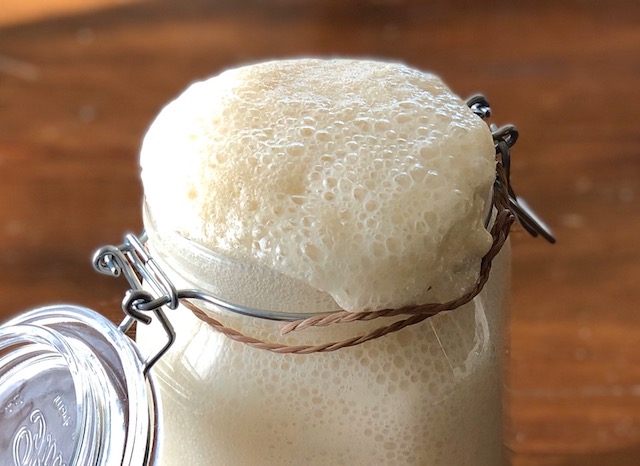
- “My starter has never been that bubbly before.”
- “Your starter photos always show a large foam on top. Mine never gets that way.”
- “My starter doesn’t have the yeast life yours has.”
- “I’ve had my starter for years and it’s never looked like that.”
- “I know my starter isn’t spoiled but it never has that many bubbles. Ever!”
- “What do I have to do to get my starter to look bubbly like yours?”
Before we troubleshoot, let me say that maintaining a starter takes practice. It’s why some people are diehard sourdough bakers while others give up. It requires patience, experimentation, and time.
Lucky for us, Amish Friendship Bread starters are easier, but like all sourdough starters they still require a certain amount of care. Most of the recipes in the Friendship Bread Kitchen work with your starter in any state, but some of our featured Amish Friendship Bread artisan loaves and rolls recipes need a bubbly, frothy starter in order to get a proper rise.
The top three culprits for lackluster Amish Friendship Bread sourdough starters
- Cool or cold kitchens
- Infrequent feeding
- Incorrect feeding ratios
1. Cool or cold kitchens
Your Amish Friendship Bread starter doesn’t like cold. At all. If you have a cool kitchen, your starter won’t be as active and might even begin to go dormant. This is great if you want to store your starter, but not so great if you’re hoping to bake in a couple of days.
The ideal temperature for your starter is somewhere in the range of 75-85 °F. For traditional sourdough loaves, it’s sometimes higher, up to almost 90 °F. These warmer temperatures support the growth of different yeast strains in your starter. You want to see some bubbles and activity at least once during every feeding period.
If you want to learn more about this, I recommend visiting traditional sourdough websites or checking out a few books from the library. There’s a whole science behind it, but the bottom line is this: keep your starter warm.
If your kitchen is cold or drafty, here are some ways to keep your starter cozy:
- Store it near a sunny window
- Place it in your oven with the oven light on
- Place it near a radiator or heating element
- Place it near the cooking areas in your kitchen
- Keep it well wrapped and place it in the warmest room in your house
If these options aren’t practical for you, you may be a fair weather Amish Friendship Bread baker. If so, consider storing your starter for the winter and bringing it out once it warms up again.
>> Need to make an Amish Friendship Bread starter from scratch? Here’s the recipe.
2. Infrequent feeding
Regularly feeding your starter can be expensive and challenging. Some folks try to solve this by feeding their starter less frequently, or they just forget, and neither are good for your starter.
Your starter needs flour, sugar, and milk in order to grow. If you don’t feed it on schedule, it will turn to alcohol and start to spoil. If your starter starts to separate, it means it’s looking for food. Hungry starters are not happy starters.
Your starter needs to be fed every 6 days. I feed my starter every 5 days, and because I live in a warm climate, my starter metabolizes quickly and is usually hungry by Day 5. I also use my starter frequently, so I make sure I always have at least 2 cups on my counter. The minute it dips below, I feed it.
You only want to use starters in your recipes that are healthy and thriving. Need help feeding your starter on time? Check out my brand new Amish Friendship Bread Planner which includes a feeding schedule and fillable chart, calendar, and 50 “At a Glance” recipes that make it easy to bake regularly.
3. Incorrect feeding ratios
Another big issue with maintaining a healthy starter is feeding it properly.
It’s simple math: for every cup of starter in your jar, you’ll need to add 1 cup flour, 1 cup sugar, and 1 cup milk every 5-6 days. That doesn’t sound so bad, does it? Except that after you feed your starter, you now have more of it.
Let’s say you’re feeding your starter regularly but not baking regularly, so you’re not using up your starter as you go. If you feed on schedule (as you should — see #2 above), you’ll soon have starter coming out of your ears. Like, A LOT of starter.
Why? Because if you have now 2 cups of starter in your jar, that means the next time you feed it, you’ll have to add 2 cups flour, 2 cups sugar, 2 cups milk. Let’s pretend you go another 5-6 days. You now have approximately 4 cups of starter in your jar, which means you need to feed it 4 cups flour, 4 cups sugar, and 4 cups milk.
Yeah.
If you’re baking once a week, you’ll be removing starter as you need it so you’ll be able to keep your starter at 1-2 cups at all times. But if you’re not baking regularly (and still want to keep a starter on your counter), you’ll need to get in the habit of discarding excess starter.
I know this seems like a waste, but healthy starters need to be fed on time and at the correct ratios. Of course the easiest solution is to bake with your excess starter (the cookies and pancake/waffle recipes are a great way to use it up) or to give it away, but if you’re not up for either, stir your starter well and discard all but one cup of your starter.
There are some Amish Friendship bakers who underfeed their starters, and it seems to work for them. All I can say is that everybody’s starter, and kitchens, are different. Experiment to see what works, but at the end of the day, it’s all about taking care of your starter. The flavor will continue to develop over time, and it’s cool to have a starter that’s been around for a while.
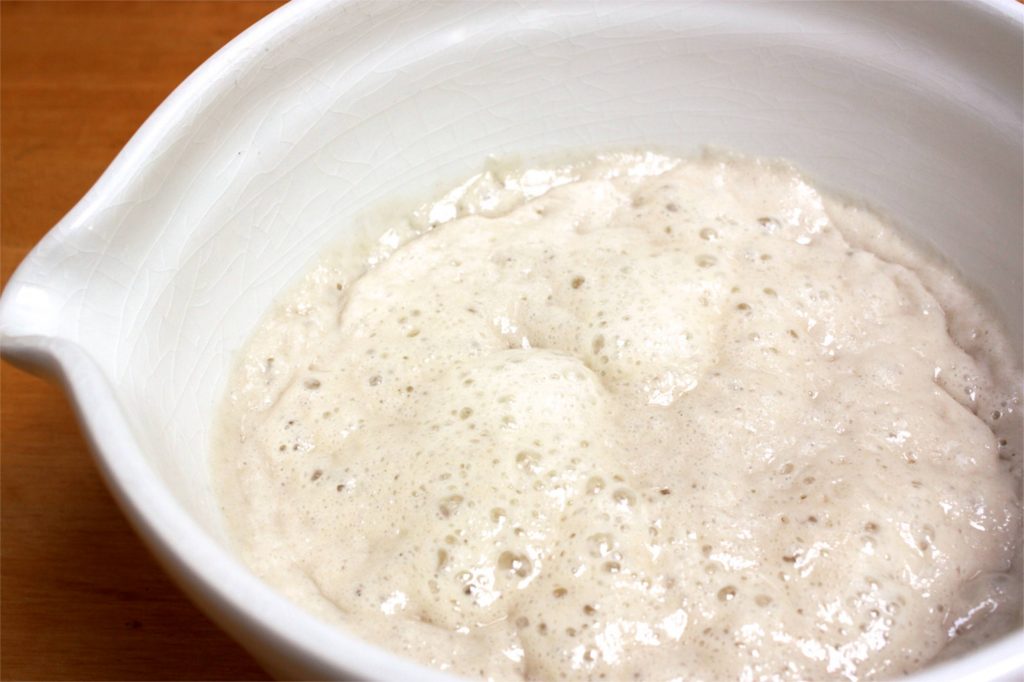
Why my starters (usually) look amazing
The Friendship Bread Kitchen isn’t in Amish country, but in our 50th state: Hawaii.
- My starters are VERY happy in this climate. They’re in a kitchen that’s 73-82 °F year round (sometimes warmer), which is optimum for yeast to thrive and multiply.
- I feed my starters a lot, sometimes more frequently than every 5-6 days because I’m baking with it regularly for the the Friendship Bread Kitchen. Those are your two big components right there: room temp and regular feeding.
- I always feed at the correct ratios. I may swap a nut milk or even water for regular milk, or lighten up on the sugar, but I always have 1 cup flour and 1 cup liquid (the basis for traditional sourdough starters), and usually 1 cup sugar since I’m always testing recipes.
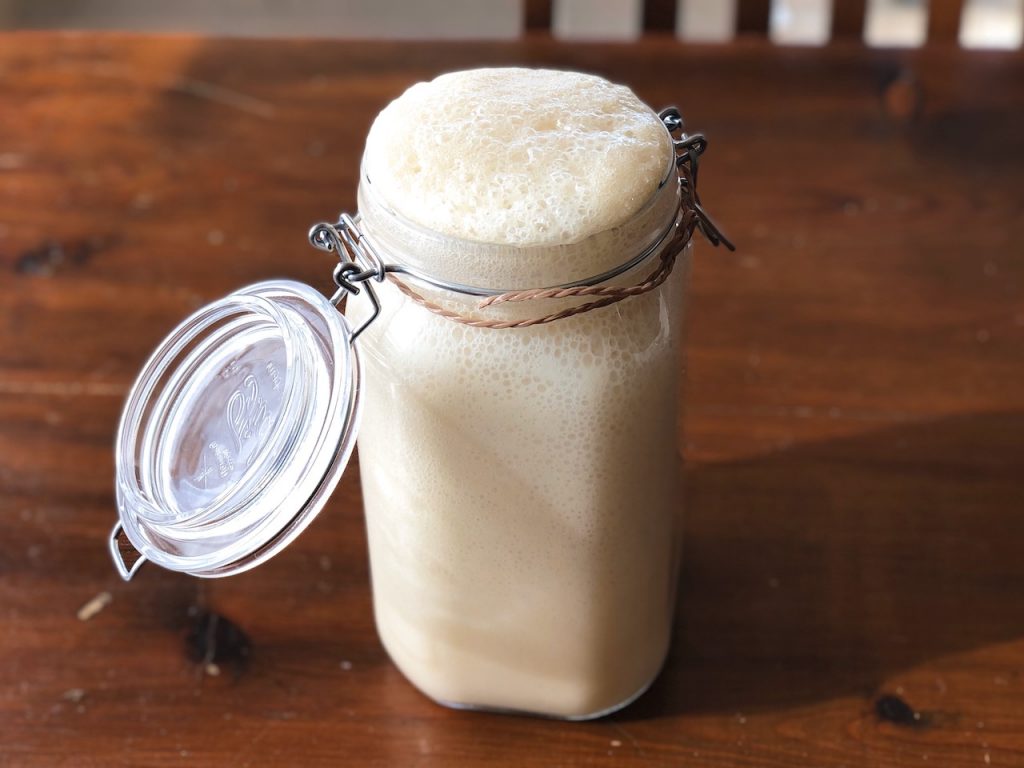
Another reason I was able to get that great shot of my Amish Friendship Bread starter: I took the picture before I stirred my starter that morning, and it hadn’t collapsed yet. A few minutes later it did, all on its own (see below). That’s why you might wake up some mornings and see that your starter looks flat and innocent, but there will be residue up the sides of your jar that tell you your starter was doing something while you weren’t looking.
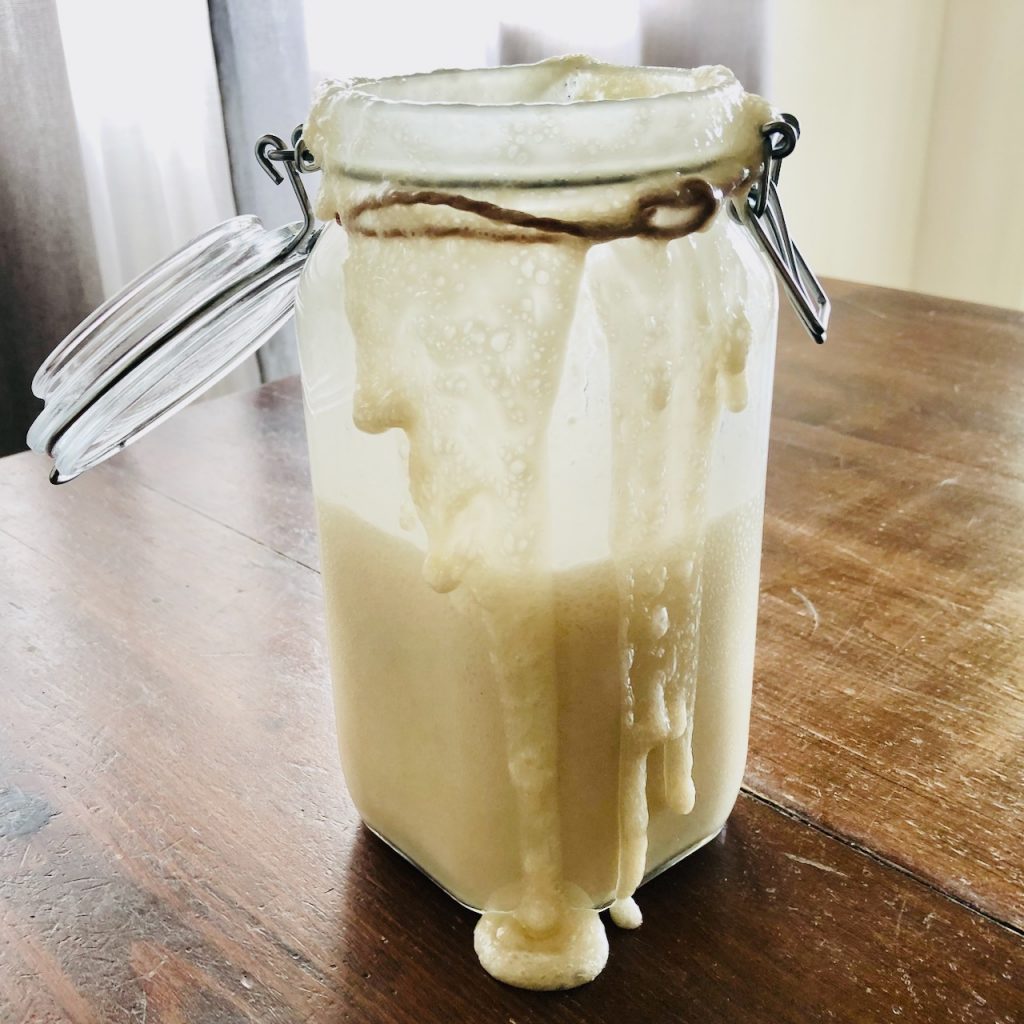
Every starter goes through a “quiet” period
Starters are always the most active after they’ve been fed — the bubbles are the indicator that they’re “eating.”
Once they’ve finished eating, they take a nap, so to speak. That’s when your starter goes quiet and still. You can expect your starter to look like this for a couple of days before you feed it.
And sometimes I do everything right, but my starter looks as flat as pancake batter. When that happens, I don’t panic. It might be the weather, the water, a super hungry starter. I keep doing what I’m doing, and sure enough, a couple of feedings later, we’re back in business, bubbles and all.
I can’t say why this is, except that maybe there are times where there are more wild yeasts in the air that contribute to an active starter, or maybe the starter itself is going through different phases. A hearty starter that’s been around for a while, as mine has, will go through moments like this. Don’t worry, it’s normal. Consider it “me time” for your starter, where it’s doing a little magic behind the curtain before it gets ready to put on a show.
- Jump to the recipe to make Amish Friendship Bread starter.
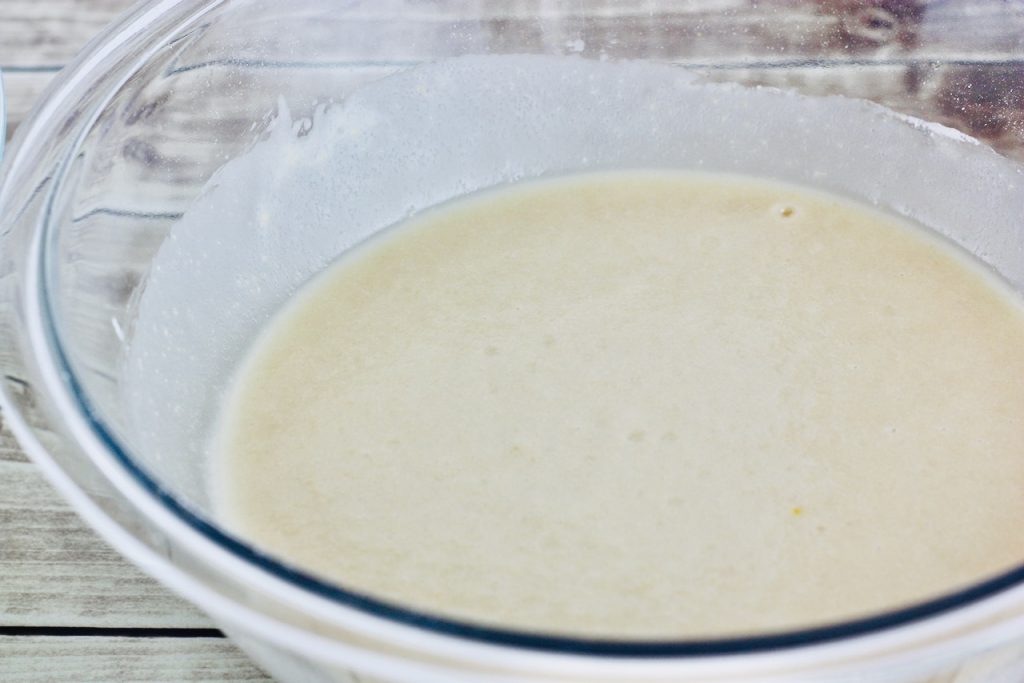
Other reasons your starter may be struggling
If you’ve determined that the problem isn’t any of the 3 main culprits above, and that your starter isn’t going through a quiet phase AND isn’t spoiled, here are a few more possibilities:
- not stirring regularly so the ingredients have a chance to get re-distributed
- other random kitchen ingredients falling into the starter and affecting (or retarding) growth of your starter
- flour, sugar or milk are contaminated or aren’t fresh
- the container had dish soap or bleach residue
- original starter (if received from someone else) wasn’t healthy or active
- original starter (if made by you) didn’t use fresh yeast or ingredients weren’t properly incorporated
- sometimes it’s just one of those things — a starter just doesn’t take, but that’s rare if you are doing all of the above
Best of luck with your starter, and please share your starter pictures on our Facebook page — I’d love to see them!
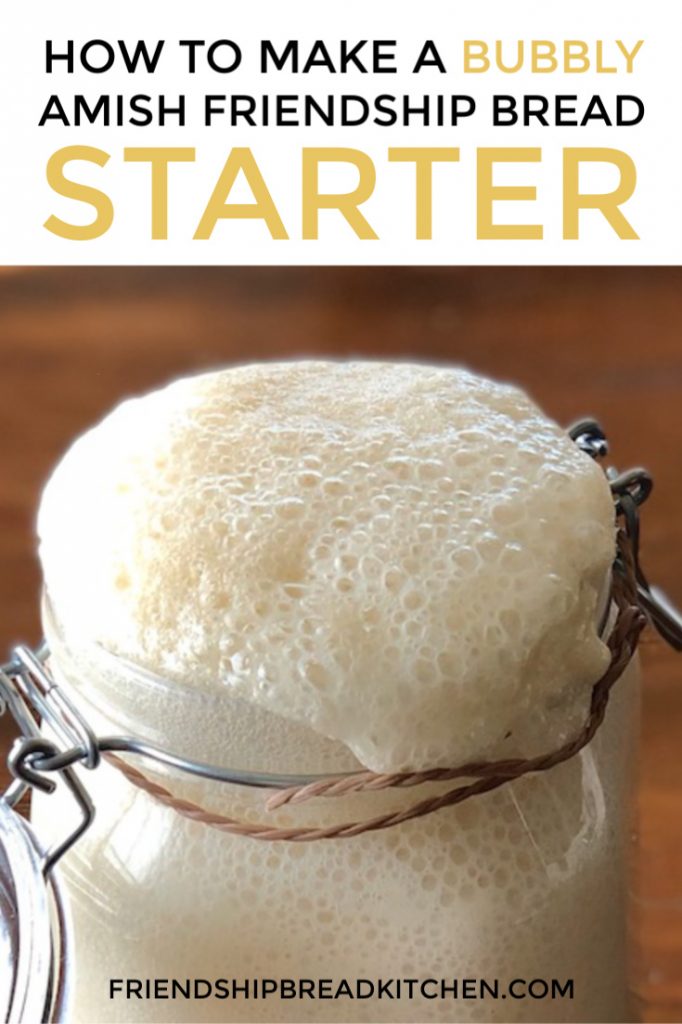
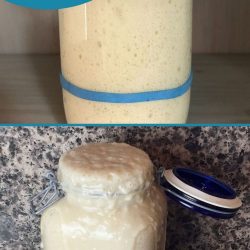
On Day 10, today, I put a loaf in the oven and went to do some work outside. I smelled something burning and ran in to 9pen the oven door. To a raging fire. I finally got the fire out and of course the bread was ruined and the ovenva disaster is. I had filled the loaf pan to the top because it didn’t say otherwise and the dough stopped over. How full should the pans be for a loaf and muffins?
Why are the jars with lids used for starters if the starter has to room tobubble and expand, and the lids are not closed?
Have you ever tried adding new yeast
to an established starter, and beginning the ten day routine as for a new starter? A friend recommended this to keep the good older
more active.
My starter recipe says, add 1/2 cup sugar, flour, and milk on day 10. Should I be adding one and a half cups?
Hi Virginia! How much you feed your starter depends on how big your starter is. As a rule of thumb, you should be feeding your starter a 1:1 ratio. For example, if your starter is 1 & 1/2, then you should feed it an 1 1/2 cup of flour, 1 1/2 cup of sugar, and 1 1/2 of milk. Let us know if you have any other questions!
I don’t understand why some potato flake starters Don’t you use any flour I thought flour was the real food of the starters do these starters without flour work well
Hi Debby! Yes, potato flake starters are a non-flour starter. The key in them is that the sugars in the potato flakes, as well as the sugar you add, are what causes the yeasts to metabolize and grow. Potato flake starters (as well as any other gluten-free starter) are usually a bit more finicky than the traditional AFB starter. Here’s a great post with more information on potato flake starters: https://www.friendshipbreadkitchen.com/101-learn-about-potato-flake-sourdough-starters/
After using or sharing the starters from a batch being stored in a jar, do you wash the jar and then then return the starter?! Thx!
Hi Debra! Yes, it’s good to give your jar a wash every once in a while. It is a personal preference on how often, but we usually wash our jar out every 2-3 10 day cycles. Happy baking!
My Kitchen is very cool because I am in the basement; However I cook or bake every day so the first thing I do is when I turn on my stove or oven is move my starter to the top of my stove that seems to be working great because I am getting a really good bubbling each day before when I stir it
That’s an awesome tip, Cissy! Thanks for sharing!
I have four bags of starter mix. I couldn’t find anyone that was interested in the starter. It has been on my counter for so far for two days. Can I just freeze the four bags and when I take a bag out, start with step 6 ? Please help!!!
Hi Holly! Yes, you definitely can!
I’m brand new to this as yeast is very hard to find now. My main question is I started with a quarter of everything (milk,sugar,flour,yeast and water). Will I still see results with this ratio? My kitchen is cold and I’m in the process of adapting the starter but wanted to know if I should have done the 1:1 ratio. I didn’t have enough yeast for the 1:1 ratio
Hello and Aloha Darien and fellow fans of this blog. Now I believe that if I have absorbed the many great info posts on this beauty that it is not suitable for my Northern Ontario Arctic winters…yes, we have a different name for us up here compared to the Central and Southern Ontario winters, but I really want to confirm in case I missed something. The top of our fridge stays same temp as house all year round, we heat our home maximum 69 degrees from late October to end of May. I believe this means this gorgeous Amish Friendship Bread is not an option for me even if I kept it completely in our propane oven the whole of our fall, winter spring season. Yes, I am very disappointed but if anyone can correct me where my thinking may have gone off track please do.
Until next time cheers to the wellbeing and good health to all of you and yours in circle and the same to our world in the Universe of humanity…during such a frightening time for countless people. Regards, Linda
Hi Linda! In the warmer months (or, believe it or not, the colder months where you have heating elements running in the house), you can give the starter a try. The good news is that you kick it off with regular yeast, which gives the starter a chance to develop. You don’t need to keep it in your oven with the light on (not practical for the long term), but you can place it near a heater (like the water heater or a radiator) and also keep it wrapped. Someone posted about keeping theirs wrapped and tucked in a shoebox! Sometimes a starter will surprise you so if you have some flour, milk, and sugar to spare, it might be worth a try. In this case, I would keep it in a one-gallon Ziploc bag, zipped up. When it gets puffy, let the air out. If it looks like it just isn’t working, you could then toss the bag in the freezer and wait for summer. 😊
Do you have all of the above information in recipe book form?
Not yet! That’s a great idea, though!
I guess never thought about how my starter looked. I make it the way I was taught, I thought it looked a little different because in plastic bag, but always seem to work good.
If it’s working for you, Toni, then no worries! If you keep your starter in a plastic bag, you should see it swell up every few days, almost to bursting. The next time I feed it, I’ll move part of my starter into a plastic bag and show you how what kind of activity you can expect when it’s in a bag.
this is very interesting. I am new at making Amish Friendship Bread and this will be very handy to help and identify any problems or questions I may have. thank you for this challenge. I have learned so much and plan to continue to follow you and learn more.
I also use the potato flake recipe. Mine uses 1/2 cup sugar, cup of warm water and 3 tablespoons potato flakes. My biggest problem, besides a cool kitchen, is that I have to work late sometimes and that keeps my starter out over 12 hours after feeding. That must weaken it too. 😩
Lay a dish towel on top of your refrigerator and set the starter on top of the towel.The refrigerator is warm on top(maybe too warm is why I lay a town down under mine.)I’ve kept starters for years before and got out of it a while.I was making sourdough bread at the time but don’t anymore. I just made my first friendship bread starter 2 weeks ago and made the bread this weekend.It turned out great!I’ve started a new friendship bread starter without yeast and its coming along ,its not as active as the 1st one.I’m also got some fresh strawberries in a canning jar with water fermenting. I plan on using the strawberry infused water to make a new starter(by adding sugar,milk and flour.I’m freezing them after they get more and will keep them there until I’m ready to bake.When the weather warms up in the spring I’ll put them IN the refrigerator where they won’t be as active as on the refrigerator.Hope this helps!
My home for years has been kept at 66-70 degrees in the wintertime. I have never had a problem with my starters doing what I needed, but I use my oven for proofing and the interim rest and proof. I turn on the light, and then turn it off after it warms up. But I agree that my starter doesn’t go over the top like yours, however I am only making 4 loaves at a time, and my starter has been adapted to make a sandwich bread with less sugar, but it has worked really well for me and everyone that has eaten it loves it. It is still a tiny bit sweeter than other breads, but we didn’t want a breakfast or dessert bread. Mine is the instant/dried potato starter.
Getting a Bubbly Starter is a big help
I believe my starter is cold, and hungry!!! Thanks ☺️
I have been struggling with my starter. I think I have found two reasons why. One my kitchen is cold and I had the jar on an outside wall. I have since moved it next to my oven. Two. I was not feeding enough and she was hungry. I was feeding the same amount as the day I started….I try to use starter every day but did not realize I had to add equal amounts to the starter on hand. This sure is a learning curve. Im determined!!!
Hi Sandy — keep me posted and let me know how it goes! Good luck!
Hi Darien, and MERRY CHRISTMAS !!
My starter is just fine,… I used my last batch to send out my Amish Homemade Bread and all my other Christmas Candy to my family in Virginia, Mississippi, and Texas. I also live in Texas, but six hours away from other Texas family. They always love to receive ” The Texas Treats Box “, and I love doing it. I left a cupful to start my next batch, and when it gets ready ( which is soon )! I think I will “cup it up”, and freeze this batch, ….my back ache’s LOL. When I get Christmas over, and take a big Breath, then I’ll be back on my regular schedule, but not before I make my Amish Friendship Roll’s for Christmas Dinner. I am 74 years young and me and my husband of 56 years love making bread, rolls, cakes, and cookies all from your recipes and the Great & Wonderful Amish Friendship Starter !!!!! Have a Great Year, & Merry Christmas to You & all of our Bakers this Year !!!
Sandy